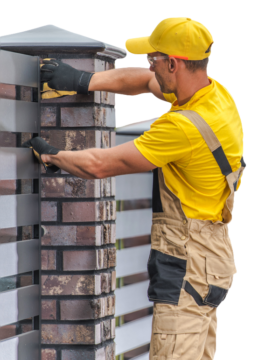Fences are the first line of defense for your home and property. Keeping your fence in good condition helps to prolong the lifetime of this important outdoor structure. Take time to spot damage that may be caused by weather and learn what to do afterwards to repair or replace the damaged parts.
First, Inspect Your Fence Annually and After Property Damaging Weather Events
Fence manufacturers have specific requirements for ongoing maintenance and inspection of the entire fence at least once a year and after any significant and potentially damaging to property weather events. These weather-related damages may be just a small stain, warped fence parts, sagging gates or the fence could be laying on the ground.
Weather events that can cause serious damage to any type of fence include strong thunderstorms, hurricanes, tornados, widespread floods, water or sewer line backup close to the fence, faded fence surfaces from direct and harsh sunlight exposure and many other incidents.
Common Types of Fence Damage Often Caused by Weather Related Situations
Property owners are strongly urged to learn what different types of fence damage, caused by weather situations, look like. Knowing what to do may save your valuable fence.
Read on for more specific weather causing damages that could negatively impact your fence.
Temperature Extremes
Many politicians, environmental activists, scientist and other people have already sounded the alarm on rising sea levels, worldwide climate changes due to warmer weather that are causing frozen glaciers to melt faster than any recent time. Global warming has been blamed for a wide variety of weather-related differences that includes longer heat and cold spells often with extreme temperature variations.
These temperature extremes have been linked to bigger and more frequent superstorms that have resulted in widespread property damages, astonishing high injuries and even death in the worst-case scenarios. These dramatic shifts in temperature can wreak havoc on outdoor structures that include fences with some types of wooden fences being more prone to these problems than other fencing materials.
What to Do:
Homeowners can apply a protective finish product to their bare fence material. Some products help to block harmful UV rays from the sun. Installing a different type of fence often eliminates the problem.
Hail and/or Snow
Severe weather changes often form large hailstones that can rain down golf-ball sized, and larger, hailstones known for being especially damaging to motor vehicles, a home’s roof and exterior surfaces and structures, such as storage sheds, patio coverings and more.
Heavy accumulation of hail or snow can also cause trees and power lines to break or fall due to the pressure. Heavy snow can be dangerous if it piles up onto roofs or is pushed near a fence resulting in unwanted damages.
These are life-threatening situations when live power lines and heavy tree branches or roofs suddenly snap and fall to the ground. Anybody or anything in the path could be seriously injured or these individuals could die either at the event time or later due to complications.
What to Do:
Place your fence back further from your road and be vigilant about when the snowplows go through during snowfalls or hailstorms. Carefully brush the substances away. This may take some time and greater effort, but a damaged fence can be even more stressful.
Move your automobiles to a safe and covered location, and never attempt to get near any downed power lines as this could be deadly. This is a time to call in professionals.
Exposure to Harsh Sunlight
Fences that are made of wood and other types are prone to noticeable fading caused mainly from excessive exposure to hot and scorching sunlight. Painted fences may become blistered creating paint chips that expose untreated raw materials underneath.
What to Do:
Ideally, carefully choose a fence material that better handles strong sunlight. Use protective products that can help bounce UV rays off the fence surface.
Ice Build-Up
Along with hail and snow, ice can build-up on fences increasing the pressure on this structure that over time may result in various fence damages. Ice can be heavy and will stick to the fence surfaces increasing the likelihood of breaking the fence’s supportive integrity. This often results in a fence that topples over.
What to Do:
Fences are very likely to sustain greater damage due to their smaller size and their placement outdoors exposed to the elements. Carefully scrape this built-up ice away. Check fence posts and ensure that they are still secured into the ground.
Rain & Moisture
Excess moisture from rain or another source can be detrimental to fences. Metal and wooden fences run the greatest risk of this particular damage. The damp wood can result in the more serious damage of warping or bowing outward setting the fence up for failure. Metal fences may develop rust which is corrosive and can break down the outer surfaces of the fence material causing serious harm.
Rain that pools on the ground near to the fence posts can result in a soggy mess that sometimes causes the soil to change often causing the support posts to move and become unsteady.
What to Do:
Protective coatings can help. Investigate the ground and soil that encircles that support posts. If there is a drainage issue, this will need fixed quickly. A long-term solution is to install a fence that better handles moisture like vinyl or treated metal among others.
Wind
High winds can be strong enough at sea to propel a boat across the waters. This is similar to how high winds can gather enough force to topple or damage fences that happen to be in the wrong place.
Tall fences and those without air spaces allowing cooling breezes to waft through are susceptible to potential wind damage.
What to Do:
If your home is in an area that sees powerful storms often with accompanying high winds, it is wise to select a fencing material that better withstands the pressures that wind can bring. Shoring up the posts by installing them deeper and pouring concrete around it can help.
Fix any damages promptly to avoid further problems like mold or mildew growth that becomes a more extensive and costly remedy.
Section 2:
Following your manufacturer’s recommendations for care can also help tremendously in keeping your fence intact and functionable.
Reasons to Contact a Nearby Fencing Contractor
Many property owners like to do things around the property themselves. Fence damage due to hail or from other weather-related situations can be a challenging task. Sometimes, the best remedy is to hire a team of experts.
Conclusion:
There are some simple and lesser-known methods to deal with fence damage that occurs due to powerful and destructive weather situations. Speak to a qualified fending specialist who can give you some expert advice. Fix problems promptly and apply protective measures to stop this from happening again.
Phone Denco Fence Company at (303) 223-6902 to learn more about fence related issues or request an estimate online.

Need an expert opinion? Talk to our experts today!
When you talk to our experts at Denco Fence Company, we’ll help you compare fence styles, share design ideas, and answer any questions along the way. If you’re looking to build or repair a fence that you and your neighbors are going to love, get a free estimate and let us help bring your project to life.

